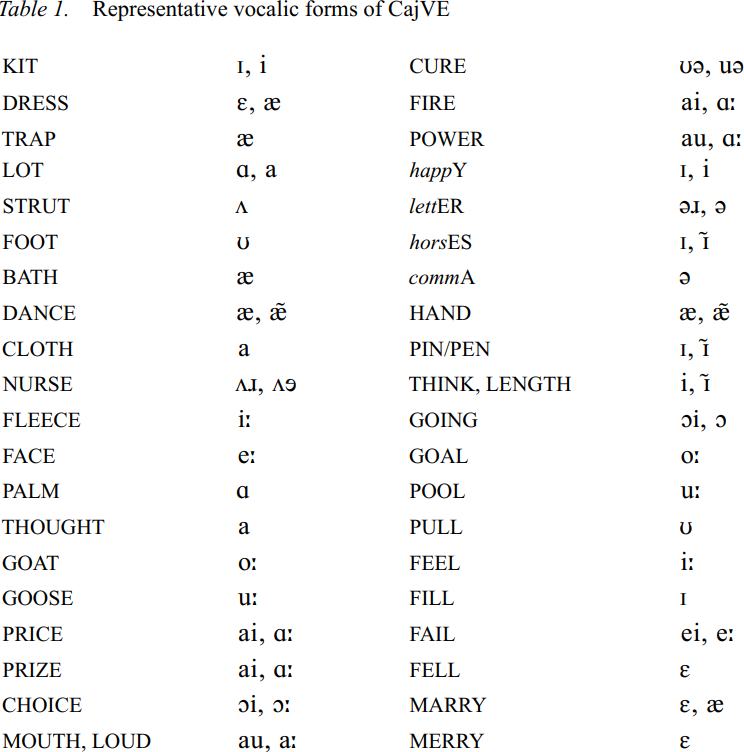


 Grammar
Grammar
 Tenses
Tenses
 Present
Present
 Past
Past
 Future
Future
 Parts Of Speech
Parts Of Speech
 Nouns
Nouns
 Verbs
Verbs
 Adverbs
Adverbs
 Adjectives
Adjectives
 Pronouns
Pronouns
 Pre Position
Pre Position
 Preposition by function
Preposition by function 
 Preposition by construction
Preposition by construction
 Conjunctions
Conjunctions
 Interjections
Interjections
 Grammar Rules
Grammar Rules
 Linguistics
Linguistics
 Semantics
Semantics
 Pragmatics
Pragmatics
 Reading Comprehension
Reading Comprehension|
Read More
Date: 15-3-2022
Date: 2024-07-03
Date: 2024-04-12
|
We summarized the CajVE vocalic system. The phonetic inventory of CajVE is similar to Southern English. However, CajVE speakers do not prolong stressed vowels and diphthongs.


Glide absence in FLEECE, FACE, GOAT, GOOSE is typical of CajVE. Their nuclei do not fall or become fronted as in Southern English. The nuclei of KIT may rise but CajVE speakers lower the DRESS vowel in words such as Texas, bed, red, better, well and egg to [æ]. Consequently the words bed and bad sound the same, although the word bed, pronounced [bæ] has a shorter length than the word bad pronounced [bæ:]. Although CajVE shows the PIN/PEN and THOUGHT/LOT mergers, upgliding forms of THOUGHT, BATH and DANCE occur irregularly. By contrast, monophthongization of PRICE, PRIZE, CHOICE, FIRE, MOUTH, and POWER is prevalent. The non-rhotic aspect of CajVE can also be observed in NURSE, SQUARE, NORTH, FORCE (the last two are merged), CURE, and lettER. Like Southern English, the happY and horsES vowels are pronounced [ɪ], and commA as [ə]. Like the old white Southerners, CajVE speakers do not merge POOL/PULL, FEEL/FILL, FAIL/FELL. However, the vowels in MARRY/MERRY/MARY are usually identical, but those in TOMORROW/ORANGE may be distinct.
CajVE provides an interesting case of shared phonetics with the dialects in its geographical region while maintaining a distinctive coherence as a separate dialect. The distinctiveness of CajVE is initially revealed quantitatively. Where comparisons can be made, the patterns of variability are not the same in terms of linguistic conditioning in each generation of speakers. Moreover, the actual rate of use of the features often far exceeds the results reported for Southern English varieties. When the scope of the variability is widened to include more data, i.e., the widespread deletion of all final consonants and the glide absence, it becomes clear that CajVE is qualitatively distinctive as well from Southern English, and especially American English.
|
|
|
|
مخاطر خفية لمكون شائع في مشروبات الطاقة والمكملات الغذائية
|
|
|
|
|
|
|
"آبل" تشغّل نظامها الجديد للذكاء الاصطناعي على أجهزتها
|
|
|
|
|
|
|
تستخدم لأول مرة... مستشفى الإمام زين العابدين (ع) التابع للعتبة الحسينية يعتمد تقنيات حديثة في تثبيت الكسور المعقدة
|
|
|